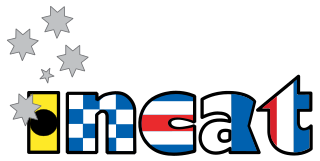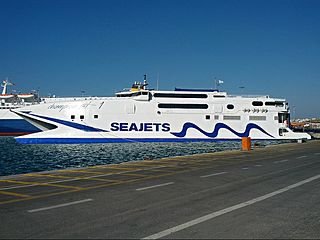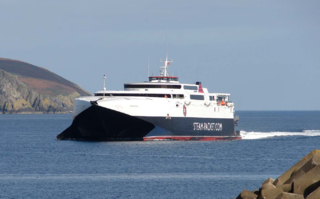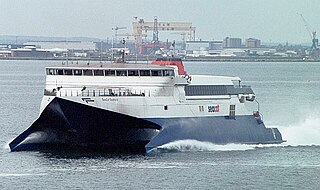
Bay Ferries Limited, or simply, Bay Ferries, is a ferry company operating in eastern Canada and is headquartered in Charlottetown, Prince Edward Island, Canada. It is a subsidiary of Northumberland Ferries Limited and a sister company to the defunct Bay Ferries Great Lakes Limited.

Incat Tasmania is an Australian manufacturer of high-speed craft (HSC) catamaran ferries. Its greatest success has been with large, sea going passenger and vehicle ferries, but it has also built military transports and since 2015 it has built smaller river and bay ferries. Based in Derwent Park, a suburb of Hobart, Tasmania, Australia, it was founded by Bob Clifford.

Molslinjen is a Danish company that operates ferry services between Jutland and Zealand, and also services to Bornholm. In March 2017, the routes in the Kattegat were renamed to Molslinjen.

HMAS Jervis Bay was a wave piercing catamaran that operated in the Royal Australian Navy (RAN).

HSC Condor Voyager is a high-speed catamaran ferry, owned by Brittany Ferries and chartered to Condor Ferries. Since being built in 2000, the vessel has borne the names Incat Tasmania, The Lynx and Normandie Express. She is designed to travel at speeds of up to 46-and-a-half knots, giving a journey time between Portsmouth and the Normandy ports of three hours per crossing.

HSC Champion Jet 3 is a fast ferry operated by Seajets. Launched in 1997, she was initially chartered out as a civilian ferry, then became the first large catamaran to enter military service when she was commissioned into the Royal Australian Navy as HMAS Jervis Bay (AKR 45) from 1999 to 2001.

The HSC Champion Jet 1 is an 86m fast catamaran ferry operated by Seajets Ferries. She was until early 2015 owned by Condor Ferries and called HSC Condor Vitesse.

The HSC Champion Jet 2 is an 86 m (282 ft) fast catamaran ferry owned by Greek ferry firm Seajets. Between 1997 and early 2015, she was operated by Condor Ferries and ran between the UK and the Channel Islands as Condor Express.

HSC INCAT 046 was a wave-piercing catamaran passenger-vehicle ferry. It operated under various marketing names, including Devil Cat, The Cat, The Lynx, and lastly The T&T Express.

HSC Skane Jet is an Incat-built, ocean-going catamaran. It is one of the world's fastest car carrying passenger vessels and, as Cat-Link V, set the eastbound record for the fastest transatlantic journey. In 1998/1999, the ship sailed as Cat-Link V on the Århus-Kalundborg route in Denmark—then operated by Scandlines. From 1999 to 2005 it sailed as Mads Mols for Mols-linien. From 2005 to 2006 it was renamed Incat 049 by T&T Ferries in Trinidad and Tobago. In 2006 it was renamed Master Cat and has since been operating on the route between Kristiansand in Norway and Hanstholm in Denmark, later changed to Hirtshals, in the service of "Master Ferries". This company was merged with Fjord Line on 1 January 2008 and the ferry was renamed Fjord Cat.

The HSC High Speed Jet is a 74 m (243 ft) ocean-going catamaran built in 1990 by Incat for Hoverspeed and currently owned by Seajets. In 1990, as Hoverspeed Great Britain, she took the Hales Trophy for the fastest eastbound transatlantic journey, making the run, without passengers, in three days, seven hours and fifty-four minutes, averaging 36.6 knots.

The HSC Superexpress is a 91-metre (299 ft) wave piercing catamaran built by Incat, owned by Golden Star Ferries and chartered to Viking Line. During her delivery voyage on 9 June 1998, as Catalonia, she set the record for the fastest Atlantic Eastbound Record, previously held by another Incat craft Hoverspeed Great Britain. She made the 3,125 mi (5,029 km) run from Manhattan, US to Tarifa, Spain in 3 days 7 hours 54 minutes, traveling at an average speed of 38.877 knots.

HSC Manannan is a 96-metre (315 ft) wave-piercing high-speed catamaran car ferry built by Incat, Australia in 1998. After commercial service in Australia and New Zealand, she was chartered to the US military as Joint Venture (HSV-X1). Now owned and operated by the Isle of Man Steam Packet Company, she mainly provides a seasonal service between Douglas Harbour and Port of Liverpool.

Naxos Jet is a high speed catamaran operated by Seajets in the Aegean.

The HSC Elite Jet is a high-speed ferry operated by Seajets and operated on Stena Line's Holyhead - Dún Laoghaire route and seasonally on the Fishguard - Rosslare service. She was marketed by Stena Line as the Stena Express. In 2019 was sold by Seajets and now is under repairs at Salamis. The ship is set to be launched on the Santorini - Rethymno route in 2023.

Volcan de Teno is a high speed catamaran operated by Naviera Armas.

The HSC Cat is a high speed catamaran ferry built by Incat for Sea Containers in 1990. It has been owned by Sea and Sun Maritime Co. since 2014. The vessel is currently operated by Seajets.

The HSC Mega Jet is a high speed catamaran operated by Seajets.

MV or HSCSaint John Paul II is a high-speed catamaran ferry owned and operated by Virtu Ferries. Built by Incat in 2017–18, the vessel entered service as a ferry between Malta and Sicily in March 2019. It is the largest vessel of its kind in the Mediterranean Sea, and the second largest in the world.




















